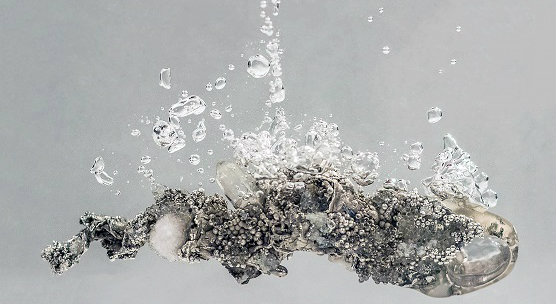Beautiful jewellery to provoke debate on climate change
Published On Tue 24 May 2016 by Grant Hill

A University of Dundee student has combined her passion for the environment, love of experimentation and metalwork skills to produce stunning rings and other items of jewellery that highlight the issue of rising sea temperatures.
Chloe Lewis says she has always been drawn to polar icecaps and the layers of frozen water that form into frost flowers - exquisite patterns that resemble delicate blooms. During her time on the Jewellery & Metal Design programme she began thinking about ways she could communicate the issue of global warming and, in particular, the risks it poses to the Arctic region she sees such beauty in.
Chloe, who is one of the near-300 graduates exhibiting at this year’s Art, Design and Architecture Degree Show, hit upon the idea of exploring what happens to different types of metal when they are dropped in water heated to varying degrees. The result are spectacular and unique pieces which share many aesthetic characteristics with both frost flowers and coral reefs, which are also threatened by climate change.
“Global warming is having a devastating effect on the Arctic region, creating fluctuating sea surface temperatures,” she said. “My research has paralleled these changes, using drop water casting in different water temperatures to create different forms in pewter from small and compacted to long and spiky shapes. Crafting these experiments into wearable art has enabled me to further explore and develop new ways to draw attention to this hugely important issue.
“The first stage was to melt down metal into liquid form and pour into different temperatures of water to see what difference it made. It was mixed with resin and other things and I tried it with silver and pewter. I further developed this by water-casting wax and vacuum and casting it into copper. There were so many times that I thought I needed to stop this as I didn’t know where I was going. It was so different to anything I’d done before and what anyone else was doing that it originally scared me but I’m glad I pursued it and am delighted with how they turned out.
“There were three main temperatures I used - 11.9 degrees, 57 degrees and just below freezing. The lower temperature gave us a compact shape, whereas the upper one looked like an explosion and at 57 degrees it tended to break up more. Every metal tried reacted completely differently and produced a unique outcome but the pieces I am most happy with are the frosty-looking silver rings that were created at 11.9 degrees. These pieces demonstrate the dramatic impact the cold water has on molten pewter and the tall compact outcomes have created the boldest pieces within my collection.”
Twenty-one-year-old Chloe, originally from Middlesbrough, is currently applying for several residency programmes and says she would like to continue making statement and wearable pieces in the future as well as exploring more ways to make her own practice more sustainable. She has been shortlisted as a potential exhibitor in Visual Art's Scotland Graduate Showcase as part of their next major exhibition at the Royal Scottish Academy in December.
Chloe and her fellow graduates from art, design and architecture programmes are exhibiting at Degree Show 2016 at Duncan of Jordanstone College of Art and Design, part of the University. Admission is free and the show if open from 10am until 8pm (Monday – Friday) and 10am to 4pm (Saturday – Sunday) until Sunday, 29th May.
More information is available at http://www.dundee.ac.uk/djcad/degreeshow/.
If you are interested in studying Jewellery & Metal Design, visit the course page.
For media enquiries contact:
Grant Hill
Press Officer
University of Dundee
Nethergate, Dundee, DD1 4HN
Tel: +44 (0)1382 384768
Mobile: 07854 953277
Email: g.hill@dundee.ac.uk